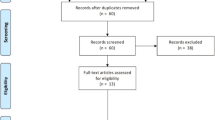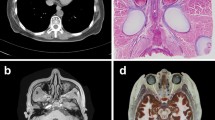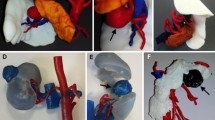Abstract
Purpose
Many regions worldwide report difficulties in recruiting applicants to surgery. One strategy proposed to reverse this trend consists of early exposure of medical students to the field. Against this backdrop, the present study presents an innovative approach for anatomy teaching, integrating a surgically relevant trend: 3D printing.
Methods
Whole-body computed tomography (CT) was made of two cadavers. Twelve students performed measurements and 3D reconstructions of selected anatomical structures (Osirix, Mimics). 3D printed (3DP) models were obtained (ZPrinter 310 Plus), and the students completed the analogous measurements on these replicas. Finally, classical anatomical dissection was performed and the same parameters were measured. The differences between the values obtained by the three modalities were submitted to standard statistical analysis (Wilcoxon two-tail paired test).
Results
Qualitative comparison of the digital 3D reconstructions based on the students’ manual CT segmentation and the anatomical reality showed excellent correlation. Quantitatively, the values measured on the CT images and the physical models created by 3D printing differed from those measured on the cadavers by less than 2 mm. Students were highly appreciative of the approach (CT, 3DP, cadaver). Their average satisfaction score was 5.8 on a 1–6 scale.
Conclusions
This study shows that the approach proposed can be achieved. The results obtained also show that CT-based 3D printed models are close to the authentic anatomic reality. The program allows early and interactive exposure of medical students to a surgically relevant trend—in this case 3D printing.


Similar content being viewed by others
References
Alsaif HA, Ramadan WS (2010) An anatomical study of the aortic arch variations. JKAU Med Sci 17:37–54
Angelini P (2007) Coronary artery anomalies. An entity in search of an identity. Circulation 115:1296–1305
Are C, Stoddard HA, Thompson JS, Todd GL (2010) The influence of surgical demonstrations during an anatomy course on the perceptions of first-year medical students toward surgeons and a surgical career. J Surg Educ 67:320–324
Babademez MA, Günbey E, Ozmen E, Celik E (2013) Anomalous relationship of coexisting ipsilateral recurrent and nonrecurrent inferior laryngeal nerves during thyroid surgery. J Craniofac Surg 24:e190–e192
Bezerra AS, D’Ippolito G, Faintuch S, Szejnfeld J, Ahmed M (2005) Determination of splenomegaly by CT: is there a place for a single measurement? AJR 184:1510–1513
Bland KI, Isaacs G (2002) Contemporary trends in student selection of medical specialties: the potential impact on general surgery. Arch Surg 137:259–267
Cesmebasi A, Du Plessis M, Iannatuono M, Shah S, Tubbs RS, Loukas M (2014) A review of the anatomy and clinical significance of adrenal veins. Clin Anat 27:1253–1263
Chae MP, Rozen WM, McMenamin PG, Findlay MW, Spychal RT, Hunter-Smith DJ (2015) Emerging applications of bedside 3D printing in plastic surgery. Front Surg 2:25. doi:10.3389/fsurg.2015.00025
Deedar-Ali-Khawaja R, Khan SM (2010) Trends of surgical selection among medical students and graduates: a global perspective. J Surg Educ 67:237–248
Dodge JT, Brown BG, Bolson EL, Dodge HT (1992) Lumen diameter of normal human coronary arteries. Influence of age, sex, anatomic variation, and left ventricular hypertrophy or dilation. Circulation 86:232–246
Esses SJ, Berman P, Bloom AI, Sosna J (2011) Clinical applications of physical 3D models derived from MDCT data and created by rapid prototyping. Am J Roentgenol (AJR) 196:W683–W688
Fanucci A, Cerro P, Fanucci E (1988) Normal small-bowel measurements by enteroclysis. Scand J Gastroenterol 23:574–576
Fasel J (1995) Clinical Anatomy Research Group—Junior. http://gracjunior.unige.ch. Accessed 7 Apr 2015
Fasel J, Mentha G, De Maeseneer J (2014) Teaching clinical anatomy: from general practice to state-of-the-art surgery. Eur J Anat 18:49–54
Fasel JHD, Morel P, Gailloud P (2005) A survival strategy for anatomy. The Lancet 365(9461):754
Gawad N, Moussa F, Christakis GT, Rutka JT (2013) Planting the “sead”: early comprehensive exposure to surgery for medical students. J Surg Educ 70:487–494
Hager A, Kaemmerer H, Rapp-Bernhardt U, Blücher S, Rapp K, Bernhardt TM, Galanski M, Hess J (2002) Diameters of the thoracic aorta throughout life as measured with helical computed tomography. J Thorac Cardiovasc Surg 123:1060–1066
Insull PJ, Kejriwal R, Blyth P (2006) Surgical inclination and anatomy teaching at the University of Auckland. ANZ J Surg 76:1056–1059
Kahn D, Pillay S, Veller MG, Panieri E, Westcott MJ (2006) General surgery in crisis—the critical shortage. S Afr J Surg 44:108–112
Kang KY, Lee YJ, Park SC, Yang CW, Kim YS, Moon IS, Koh YB, Bang BK, Choi BS (2007) A comparative study of methods of estimating kidney length in kidney transplantation donors. Nephrol Dial Transpl 22:2322–2327
Krejza J, Arkuszewski M, Kasner SE, Weigele J, Ustymowicz A, Hurst RW, Cucchiara BL, Messe SR (2006) Carotid artery diameter in men and women and the relation to body and neck size. Stroke 37:1103–1105
Malik HH, Darwood AR, Shaunak S, Kulatilake P, El-Hilly AA, Mulki O, Baskaradas A (2015) Three-dimensional printing in surgery: a review of current surgical applications. J Surg Res. doi:10.1016/j.jss.2015.06.051 (Epub ahead of print)
Mashiko T, Otani K, Kawano R, Konno T, Kaneko N, Ito Y, Watanabe E (2015) Development of three-dimensional hollow elastic model for cerebral aneurysm clipping simulation enabling rapid and low cost prototyping. World Neurosurg 83:351–361
OHSU (Oregon Health and Science University): Gastrointestinal measurements. www.ohsu.edu/xd/education/schools/school-of-medicine/departments/clinical-departments/diagnostic-radiology/imaging-section/pediatric/gastrointestinal-measurements.cfm. Accessed 21 Mar 2014
Patterson NW, Teates CD (1985) CT measurements of the anterior portions of the diaphragm with illustrative abnormal cases. Comput Radiol 9:61–65
Rengier F, Mehndiratta A, von Tengg-Kobligk H, Zechmann CM, Unterhinninghofen R, Kauczor HU, Giesel FL (2010) 3D printing based on imaging data: review of medical applications. Int J Comput Assist Radiol Surg 5:335–341
Salik E, Daftary A, Tal MG (2007) Three-dimensional anatomy of the left central veins: implications for dialysis catheter placement. J Vasc Interv Radiol 18:361–364
Seyfer AE, Welling D, Fox JP (2007) The value of surgeons teaching anatomy to first-year medical students. Bull Am Coll Surg 92:8–14
Shabana W, Peeters E, De Maeseneer M (2006) Measuring thyroid gland volume: should we change the correction factor? Am J Roentgenol (AJR) 186:234–236
Stanford School of Medicine (2015) Clinical anatomy in the Department of Surgery. http://anatomy.stanford.edu. Accessed 7 Apr 2015
Tartière D, Seguin P, Juhel C, Laviolle B, Mallédant Y (2009) Estimation of the diameter and cross-sectional area of the internal jugular veins in adult patients. Crit Care 13:R197
Wanhainen A, Bergqvist D, Björck M (2002) Measuring the abdominal aorta with ultrasonography and computed tomography – difference and variability. Eur J Vasc Endovasc Surg 24:428–434
Watson RA (2014) A low-cost surgical application of additive fabrication. J Surg Educ 71:A2–A3
Author information
Authors and Affiliations
Corresponding author
Rights and permissions
About this article
Cite this article
Fasel, J.H.D., Aguiar, D., Kiss-Bodolay, D. et al. Adapting anatomy teaching to surgical trends: a combination of classical dissection, medical imaging, and 3D-printing technologies. Surg Radiol Anat 38, 361–367 (2016). https://doi.org/10.1007/s00276-015-1588-3
Received:
Accepted:
Published:
Issue Date:
DOI: https://doi.org/10.1007/s00276-015-1588-3




